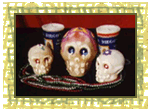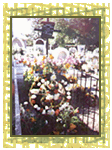 |
 |
 |
|
|||

Celebrating the Day of the Dead Dear Rudy, Autumn comes sooner than you might expect in the mountains of Mexico. Somewhere around the middle of September there is a slight chill in the air and the smell of burning fields brings back memories of childhood bonfires. 
Michoacán, one of the most beautiful and unspoiled states in Mexico, is about a hundred miles west of Mexico City. In addition to being a sanctuary for Monarch butterflies it is also the home of the Purepetcha Indians who live much as they did five hundred years ago. Women in hand-woven shawls and embroidered blouses still fill the markets with pottery and woolen serapes and at this time of year, sugar skulls and elaborate flower wreaths for Día de los Muertos, or Day of the Dead. Day of the Dead, which begins at midnight on November 1, is celebrated all over Mexico as a time when the souls of the departed return to be with their loved ones and share their favorite foods together on elaborately decorated graves. It's not Halloween by any means even though in some of the more Americanized towns ugly plastic pumpkins and polyester superhero costumes have taken over certain stalls that only a few years ago were selling miniature papier-mâché skeletons that one could have dressed and painted to look like their grandmother. 
My favorite place to go for this magical fiesta is is Patzcuaro, Michoacán, which is about an hour outside of Morelia. It's a tiny fishing village which over the years has become a gathering place for indigenous crafts people from every part of the state to bring their wares and honor their dead at the same time. In all my travels I have never seen such a concentration of every manner of beauty. Hotels are usually booked up in Patzcuaro months in advance, but Morelia is only an hour away and always has plenty of places to stay for less than $20 a night. My own favorite is the Hotel del Carmen, which is $8 and close to the bus station. A bus from there is less than $3. But if money is no problem, you can take a taxi all the way for about $15. The wonderful surprise that awaits you in Patzcuaro is that the panteón, or graveyard, is on a tiny island, the island of Janitzio, in the middle of the lake. You have to take a ferry to get there. But don't worry, one leaves the docks every twenty minutes all night long. There is something in that ritual of floating over the black water in a candle-lit boat in the middle of the night sharing a mysterious belief that maybe, just maybe, death is not the end, that allows me to appreciate the life I have now living here in Mexico. The Aztecs thought the Monarch butterflies were the souls of dead children returning with that message. That's why I hope the butterflies never stop coming.
Hasta luego,
|
 | American Public Media Home | Search | How to Listen ©2004 American Public Media | Terms of Use | Privacy Policy |